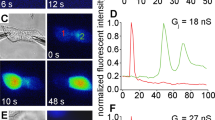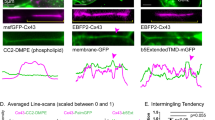Abstract
PROTOPLASMIC molecules of low molecular weight are known to travel freely across the boundaries between most neighbouring cells through small intercellular channels generally thought to be at the intramembranous particles of gap junctions1–3. The permeability of the channels can be decreased to a complete interruption of cell communication by a variety of treatments2–10. Most of these treatments raise the concentration of ionised calcium, [Ca2+], in the cytoplasm8, suggesting that calcium may be the uncoupling agent in both vertebrate9 and invertebrate cells2,8. In some systems glutaraldehyde fixation has also been shown to produce uncoupling3; however, this type of uncoupling does not seem to be triggered by calcium10. In parallel with functional uncoupling reversible structural changes have been described in gap junctions of crayfish characterised by an increase in tightness and regularity of particle aggregation and a decrease in junctional thickness and particle size10. These changes, interpreted as reflecting conformational rearrangements in the protein framework of the channels resulting in channel obliteration, were recently confirmed in the rat11 although in the latter, functional uncoupling was not measured electrophysiologically, but only presumed on the basis of reasonable comparative arguments. It remains uncertain whether or not the changes in both the gap junction structure and the cell coupling are due to a direct action of calcium on the junctional membranes. We show here that the junctional change is indeed a calcium effect, triggered by [Ca2+] as low as 5×10−7 M.
This is a preview of subscription content, access via your institution
Access options
Subscribe to this journal
Receive 51 print issues and online access
$199.00 per year
only $3.90 per issue
Buy this article
- Purchase on Springer Link
- Instant access to full article PDF
Prices may be subject to local taxes which are calculated during checkout
Similar content being viewed by others
References
Peracchia, C. Trends Biochem. Sci. 2, 26–30 (1977).
Loewenstein, W. R. Cold Spring Harb. Symp. quant. Biol. 40, 49–63 (1975).
Bennett, M. V. L. Fed Proc. 32, 65–75 (1973).
Barr, L., Dewey, M. M. & Berger, W. J. gen. Physiol. 48, 797–823 (1965).
Dreifuss, J. J., Girardier, L. & Forssmann, W. G. Pfluegers Arch. Ges. Physiol. 292, 13–33, (1966).
Loewenstein, W. R., Nakas, M. & Socolar, S. J. J. gen. Physiol. 50, 1865–1891 (1967).
Asada, Y. & Bennett, M. V. L. J. Cell Biol. 49, 159–172 (1971).
Rose, B. & Loewenstein, W. R. Nature 254, 250–252 (1975).
DeMello, W. C. J. Physiol., Lond. 250, 231–245 (1975).
Peracchia, C. & Dulhunty, A. F. J. Cell Biol. 70, 419–439 (1976).
Peracchia, C. J. Cell Biol. 72, 628–641 (1977).
Chalcroft, J. P. & Bullivant, S. J. Cell Biol. 47, 49–60 (1970).
Benedetti, E. L. et al. Biochim. biophys. Acta 457, 353–384 (1976).
Papaconstantinou, J. Science 156, 338–346 (1967).
Lowry, O. H., Passonneau, J. U., Hasselberger, F. H. & Schulz, D. W. J. biol. Chem. 239, 18–30 (1964).
Blaustein, M. P. Rev. Physiol. Biochem. Pharmac. 70, 33–82 (1974).
Peracchia, C. J. Cell Biol. 57, 66–76 (1973).
Chaberek, S. & Martell, A. E. Organic Sequestering Agents (Wiley, New York, 1959).
Délèze, J. & Loewenstein, W. R. J. Membrane Biol. 28, 71–86 (1976).
Rose, B., Simpson, I. & Loewenstein, W. R. Nature 267, 625–627 (1977).
Weingart, R. J. Physiol., Lond. 264, 341–365 (1977).
Turin, L. & Warner, A. Nature 270, 56–57 (1976).
Caspar, D. L. D., Goodenough, D. A., Makowski, L. & Phillips, W. C. J. Cell Biol. 74, 605–628 (1977).
Makowski, L., Caspar, D. L. D., Phillips, W. C. & Goodenough, D. A. J. Cell Biol. 74, 629–645 (1977).
Ashley, C. C., Caldwell, P. C., Lowe, A. G., Richards, C. D. & Schirmer, H. J. Physiol., Lond. 179, 32P–33P (1965).
Author information
Authors and Affiliations
Rights and permissions
About this article
Cite this article
PERACCHIA, C. Calcium effects on gap junction structure and cell coupling. Nature 271, 669–671 (1978). https://doi.org/10.1038/271669a0
Received:
Accepted:
Issue Date:
DOI: https://doi.org/10.1038/271669a0
This article is cited by
-
The diverse functional roles and regulation of neuronal gap junctions in the retina
Nature Reviews Neuroscience (2009)
-
Decreased gap junctional communication in neurobiotin microinjected lens epithelial cells after taxol treatment
Anatomy and Embryology (2005)
-
Channel reconstitution in liposomes and planar bilayers with HPLC-purified MIP26 of bovine lens
The Journal of Membrane Biology (1991)
-
Expression of the gap junction protein connexin43 in embryonic chick lens: Molecular cloning, ultrastructural localization, and post-translational phosphorylation
The Journal of Membrane Biology (1990)
-
Cell-to-cell communication in the heart: structure-function correlations
Experientia (1987)
Comments
By submitting a comment you agree to abide by our Terms and Community Guidelines. If you find something abusive or that does not comply with our terms or guidelines please flag it as inappropriate.



